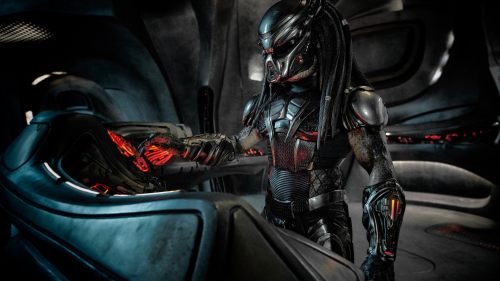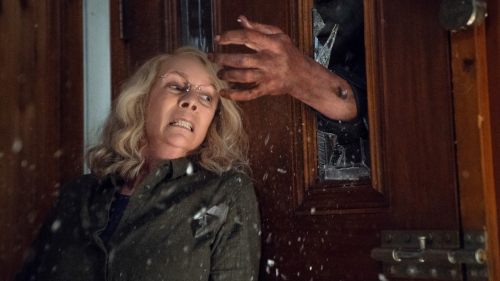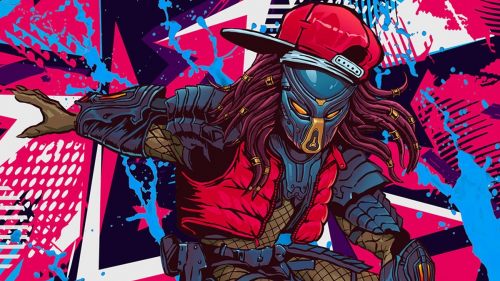No Heroes Left: Revisiting THE LAST BOY SCOUT
The Predator is out this week. Get your tickets here!
In the late ’80s, Shane Black pitched a movie to Joel Silver he called Die Hard, a buddy film about a seasoned old detective and his young sidekick. A year or two later, Silver swiped the title for a new Bruce Willis film. But Black’s screenplay became another Bruce Willis vehicle, Tony Scott’s The Last Boy Scout, the story of miserable, washed-up private eye Joe Hallenbeck (Willis) who joins up with ex-football star Jimmy Dix (Damon Wayans) to solve the murder of Jimmy’s girlfriend, which leads them to uncover a conspiracy involving an NFL team owner bribing senators into legalizing football gambling. The Last Boy Scout has everything: Bill Medley singing about football, a gunfight in an L.A. intersection, young Halle Berry, a dead squirrel, Damon Wayans riding a horse through a stadium, a bad guy liquefied by helicopter blades, Bruce Willis dancing a jig, a stuffed cat that’s packing heat, and Satan Claus.
Shane Black submitted The Last Boy Scout to his agent on a Monday morning, and by Tuesday night, the screenplay had been sold to Geffen/Warner Bros for $1.75 million. Black turned down higher offers - specifically $2.5 million - to work with producer Joel Silver again. He told New York Magazine in 1990: “There’s an expression that the Satan you know is better than the Satan you don’t know. I wanted to work with Joel Silver because I think he gets my ideas. And I thought I could deal with the people at Warner Bros. Not that I would always agree with them, but I could deal with them. It seemed like it would mean the least stress for me. Whether it’s worth what I gave up, I don’t know. But what the fuck. It’s all Monopoly money.” Between Joel Silver and Bruce Willis, who commandeered the production, there was a lot of testosterone on the screen and behind the scenes, and Scott felt powerless. At least three different editors chopped up the film, including Stuart Baird, who was brought in at the eleventh hour to salvage it. It was, by all accounts, a dismal experience for everyone involved.
Tony Scott’s singular style still pervades The Last Boy Scout. He captures the neon sleaze of Los Angeles, its golden haze and smoky blue nights, an aesthetic spawned by Don Simpson’s and Jerry Bruckheimer’s output and perfected by Scott. It’s a look more excessive than Michael Mann of the ‘80s, more restrained than Michael Bay, with notes of John Woo, his influence most evident in Bruce Willis’s affection for firing two guns while running. Yet both Black and Scott found the film lacking. Shane Black wrote: “The film is a frustrating proposition, so much potential, then a lot of ‘big action’ which evolved over time and bloated a much less grandiose blueprint. One of my big Hollywood lessons, not the first.” And Tony Scott agreed. In an interview with Empire, he admitted, “I think the script was better than the final movie.” The Last Boy Scout sometimes loses character moments in honor of excess, quick cuts, explosions, and propulsive movement forward, particularly during the third act, which is almost unrecognizable compared to the screenplay’s original finale that took place near Catalina Island, Joe’s office, and a freeway overpass. (Joe’s wife Sarah, played by Chelsea Field, is also originally given more to do, including a heroic moment when she kills the film’s most prominent villain, Taylor Negron’s Milo.) Edgar Wright called the film “an action thriller framed by flaming air quotes,” and he’s not wrong.
Shane Black ventured into directing to realize his own vision - and to keep other filmmakers’ from bungling his writing. The DNA of The Last Boy Scout’s screenplay filters into Black’s recent movies, and it feels like Black’s way of realizing its lost potential. Kiss Kiss Bang Bang’s final showdown takes place on a freeway overpass, where Sarah’s heroic moment in The Last Boy Scout’s script became Harmony’s moment. The screenplay contains within it the genesis of Black’s and Anthony Bagarozzi’s The Nice Guys. In both stories, violence erupts when our heroes meet, the catalyst for their team up is a murdered girl, one protagonist’s wife cheats on him, the other protagonist feels responsible for his wife’s death. And at the end of their adventure, they become partners. But The Nice Guys tempers the testosterone and the meanness and gives its characters more room to breathe.
Lethal Weapon was an urban western, an updated Dirty Harry, but The Last Boy Scout was Black’s first real detective story, his answer to the dearth of private eye movies being made at the time, which hews closer to hardboiled fiction than the neo-noir of The Nice Guys. In an interview with Annie Adams for The Sewanee Review, writer Megan Abbott explains: “…hardboiled novels are an extension of the wild west and pioneer narratives of the 19th century. The wilderness becomes the city, and the hero is usually a somewhat fallen character, a detective or a cop. At the end, everything is a mess, people have died, but the hero has done the right thing or close to it, and order has, to a certain extent, been restored.” By the end of The Last Boy Scout, Jimmy and Joe have killed people, they’ve been framed for killing other people, Joe’s partner and Jimmy’s girlfriend are dead, their careers are still over - but they’ve done the right thing, and Joe has his family back, and the prospect of a new partner.
Roger Ebert called the film “vilely misogynistic,” but its vileness is equal opportunity. Joe curses at his daughter Darian (Danielle Harris), Jimmy, and Sarah - and they all give back in kind. The more they love each other, the more they seem to insult each other. The film’s language is profanity and violence. Ryan Gosling’s Holland March responds to a bad situation with Jim Rockford-esque reluctance and fear, and Samuel L. Jackson’s Mitch Henessey is eternally out of his depth, but Joe faces violence with wisecracks and nihilism. And like Martin Riggs, Joe Hallenbeck has a death wish. The same authorial energy that killed off Riggs in Black’s original Lethal Weapon 2 screenplay Play Dirty lurks here in the story’s world-weariness.
But buried under all the cynical machismo is sadness, vulnerability and brief glimpses into the heroes that these characters once were. Jimmy Dix is addicted to booze, painkillers, coke, barred from the NFL for gambling charges, “another tragic tale of wasted youth.” Alcoholic Joe Hallenbeck feels like the Dark Knight Returns version of Jack Ryan: retired, aging, disillusioned, once “a regular boy scout.” Both men are ghosts, longing for their glory days - Hallenbeck once saved the President’s life in the Secret Service, Dix was the star quarterback for the L.A. Stallions. Slowly but surely, though, they begin to connect with each other, and reconnect with themselves. In a rare moment of openness, Joe listens intently when Jimmy tells him that his pregnant wife was killed while he played the best game of his life, and his son Alex lived for 17 minutes in an incubator. Alex had time for one dream, and then he died. That revelation carries more impact than any of The Last Boy Scout’s explosions. There’s even genuine affection in the way Jimmy tells Joe he’s a bastard: life sucks, but it’s a little less lonely to hear you’re a bastard from a friend than your own embittered inner monologue.
Though the final product disappointed its screenwriter, all the hallmarks of a Shane Black story endure. There’s the precocious kid still untarnished by the world who gives the protagonists a reason to get their shit together, reminds them how to be heroes, resuscitating their sense of adventure - and their conscience. There’s the shared feelings of regret, and the justified hatred of the name Chet. There’s even a touch of Christmas in the form of Darian’s drawing: Satan Claus, who has horns and holds a little girl’s severed head. Satan Claus represents all the evil, violence, and corruption in this world, from lowlifes and hitmen to senators and sports team owners: “Water’s wet, the sky is blue, and old Satan Claus, Jimmy, he’s out there, and he’s just getting stronger.” And at the heart of the story, there are two unlikely friends who remember a moment when they felt like heroes, like they mattered - and who hope they can recapture that feeling one more time. The Last Boy Scout takes a couple of shop-soiled Galahads, unites them against Satan Claus, and unearths the glimmer of good still left in them.



